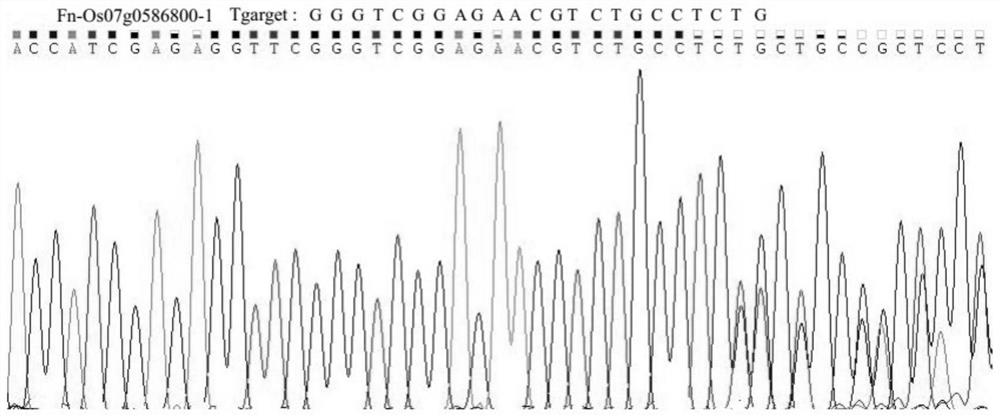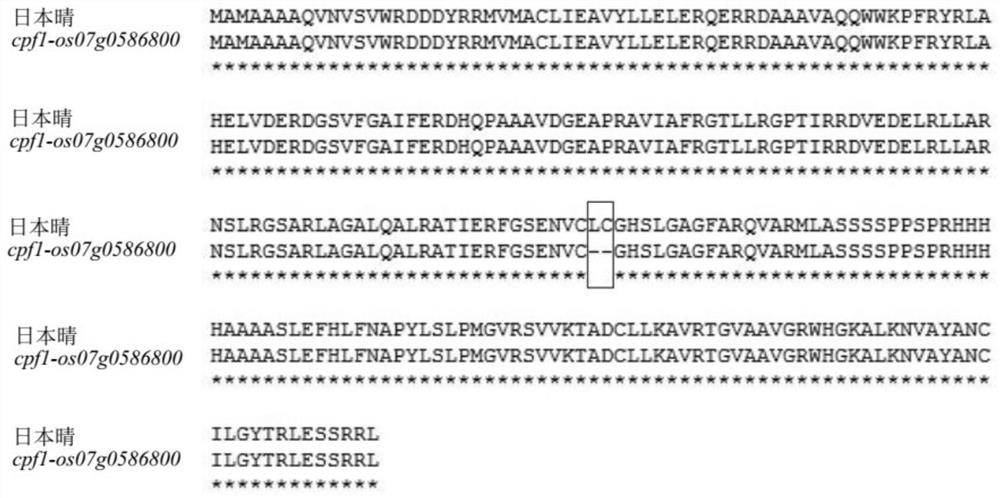Function and application of rice lipase gene os07g0586800 and its encoded protein
A technology for encoding protein and rice, applied in the field of plant genetic engineering, can solve the problems of variation, easy loss of variety resistance, narrow resistance spectrum, etc., and achieve the effect of improving the breeding efficiency and the level of bacterial blight resistance.
- Summary
- Abstract
- Description
- Claims
- Application Information
AI Technical Summary
Problems solved by technology
Method used
Image
Examples
Embodiment 1
[0061] Example 1 Fixed-point editing method of rice lipase gene Os07g0586800 based on Fn-CRISPR / Cpf1 system
[0062] 1. Sequence analysis and target sequence screening of rice lipase gene Os07g0586800
[0063] The amino acid sequence of the protein encoded by the rice lipase gene Os07g0586800 is shown in SEQ ID NO.1, and the nucleotide sequence is shown in SEQ ID NO.2. Sequence analysis shows that the gene includes 1 exon in total, located in SEQ ID NO. No. 66-827 of the NO.2 sequence.
[0064] According to the sequence analysis, the sequence on the first exon of the rice lipase gene Os07g0586800 was used as the Os07g0586800-T1 target sequence of the rice lipase gene Os07g0586800 fixed-point editing method based on CRISPR / Cpf1 technology.
[0065] After a large number of screenings, the present invention determines the positive-sense strand targeting the first exon of the rice Os07g0586800 gene using Fn-CRISPR / Cpf1 technology, using the 495th to 517th positions of Os07g058680...
Embodiment 2
[0078] Example 2 Application of fixed-point editing method based on Fn-CRISPR / Cpf1 technology in rice varieties
[0079] The recombinant Agrobacterium EH105-Fn-Os07g0586800-1 was used to infect the callus induced by mature embryos of the rice variety Nipponbare, and the obtained rice transformed plants were respectively named NIP-Fn-Os07g0586800-1; the specific method is as follows:
[0080]1. Inoculate the recombinant Agrobacterium EH105-Fn-Os07g0586800-1 obtained in Example 1 in YEB liquid medium (containing 50 μg / ml kanamycin and 20 μg / ml rifampicin), shake at 28°C and 200rpm Grow to OD 600 0.6-0.8; centrifuge at 5000rpm, 4°C for 5min, and resuspend the precipitated bacteria in AAM liquid medium (acetosyringone concentration is 200μM / L, pH 5.2) to OD 600 It is 0.6-0.8.
[0081] 2. Remove the glumes from the mature seeds of the rice variety Nipponbare, soak them in 75% ethanol for 1 min, then sterilize them in NaClO solution (mixed with water 1:2, add 1 drop of Tween 20) f...
PUM
 Login to View More
Login to View More Abstract
Description
Claims
Application Information
 Login to View More
Login to View More - R&D
- Intellectual Property
- Life Sciences
- Materials
- Tech Scout
- Unparalleled Data Quality
- Higher Quality Content
- 60% Fewer Hallucinations
Browse by: Latest US Patents, China's latest patents, Technical Efficacy Thesaurus, Application Domain, Technology Topic, Popular Technical Reports.
© 2025 PatSnap. All rights reserved.Legal|Privacy policy|Modern Slavery Act Transparency Statement|Sitemap|About US| Contact US: help@patsnap.com



